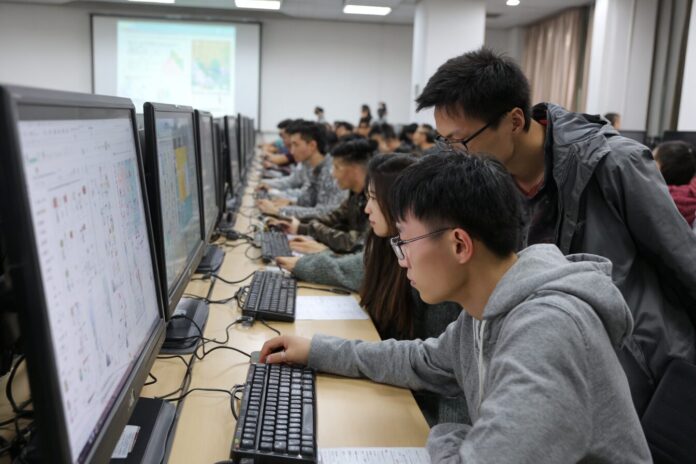Why China’s Campuses Are Doubling Down on AI Adoption
As global competition in technology intensifies, Chinese universities are taking bold steps to revamp their educational approach. Most importantly, these institutions are not only embracing artificial intelligence (AI) but are also actively encouraging its wider and smarter adoption. Because of this forward-thinking strategy, China has positioned itself as a leader on the global stage by integrating robust regulation with innovative academic practices.
Besides that, schools across China are harnessing AI to transform traditional learning models. For instance, courses now integrate practical AI projects alongside theoretical studies. Most notably, this shift is driven by the government’s ambition to produce a technologically adept workforce, ready to meet both local and international demands. Transitioning from a conventional approach to an AI-forward methodology, Chinese campuses have become hubs of cutting-edge research and digital skill development.
AI Goes Mainstream Across Chinese Higher Education
By 2025, the Chinese government mandates AI education at all levels, beginning with primary and secondary schools in major cities like Beijing. Therefore, universities are now seen as pivotal in producing AI-literate graduates who can excel in a technology-driven world. This systemic overhaul introduces students to advanced tools and techniques with hands-on learning experiences, ensuring they are well-equipped for future challenges.
In addition, the government’s AI Plus initiative plays a crucial role in promoting digital integration across various disciplines. Because this initiative creates learning environments where technology and traditional subjects converge, it fosters an innovative educational ecosystem. Furthermore, as discussed on The AI Track and evidenced by reports from CGTN, diverse tools—from adaptive tutoring systems to advanced language models—are being seamlessly incorporated into curricula, ensuring that theoretical knowledge is matched with practical application.
Expanding Enrollment and Interdisciplinary Programs
Recognizing AI as a national strategic asset, leading institutions like Tsinghua and Peking University are expanding their enrollment numbers. Most importantly, they are emphasizing interdisciplinary programs that merge AI with fields such as renewable energy, integrated circuits, and even the humanities. Because a multidisciplinary education equips students with diverse perspectives, graduates are better prepared for real-world challenges where technology intersects with everyday life.
Moreover, universities including Shanghai Jiao Tong and Wuhan University are not only broadening their AI departments but are also setting up dedicated research centers. These centers focus on innovation and practical solutions to societal problems. Consequently, the collaborative environment nurtures creativity and technological advancement, as highlighted by national media platforms like CGTN and ECNS. Therefore, by increasing access to AI education, these institutions pave the way for a future of comprehensive technological integration.
The Responsible AI Movement: Guidelines, Not Bans
Chinese universities stand out because they prefer guidelines over outright bans when it comes to AI usage. Most importantly, institutions like Fudan University are establishing clear standards that allow students to use AI tools responsibly, such as for literature reviews and data visualization. By doing so, they ensure the integrity of academic work while also leveraging technology as a learning aid.
Similarly, universities including Tianjin University of Science and Technology and Beijing Normal University have set explicit limits on the use of AI-generated content within academic submissions. Because these rules require students to disclose any AI contributions—often highlighted in red—they promote transparency in research and safeguard originality. Therefore, this balanced approach fosters an environment where technology enhances creativity without compromising critical thinking or academic ethics.
AI: An Accelerator, Not a Crutch
Recent surveys indicate that a significant portion of Chinese undergraduates, roughly 85%, integrate AI into their academic tasks. Most importantly, this integration acts as an accelerator rather than a substitute for genuine learning. Because many students initially over-rely on AI-generated content, universities are innovating classroom activities that challenge them to deliver original insights.
For example, professors design in-class challenges that require intuitive thinking and emotional depth—skills that current AI models cannot mirror. Besides that, these educational strategies ensure that AI is used to complement student creativity rather than replace it. Therefore, by emphasizing active learning and hands-on problem solving, universities are equipping students with high-level skills essential for future job markets and global competitivity.
Preparing for a Collaborative Future with AI
China’s action plan envisions a “strong education nation” by 2035, where technological innovation and quality education go hand in hand. Most importantly, this vision places AI literacy at its core, as students are prepared to navigate workplaces where humans and machines collaborate seamlessly. Because the future of work is changing rapidly, these educational reforms ensure that graduates remain competitive both locally and globally.
Besides that, collaborative AI learning programs not only enhance technical proficiency but also build essential soft skills like critical thinking and ethical judgment. As highlighted in resources such as the CGTN report, universities are partnering with industry leaders to provide real-world experience through internships and research projects. Therefore, by fostering an integrated learning environment, China is actively shaping a generation that is not only technically adept but also creatively and ethically informed.
The Takeaway: Chinese Campuses as AI Innovation Hubs
In conclusion, Chinese universities are revolutionizing educational paradigms by embedding AI into every aspect of learning. Most importantly, by implementing well-balanced guidelines rather than strict prohibitions, they are promoting an ethos of responsible and innovative use of AI. Because this model demonstrates both flexibility and strategic foresight, it serves as an inspiring benchmark for institutions worldwide.
Furthermore, as these campuses evolve into true innovation hubs, their practices are likely to influence global educational policies. Therefore, by studying China’s approach and integrating best practices, educators worldwide can harness AI’s potential without compromising intellectual rigor. Transitioning towards a future where human and artificial intelligence collaboratively drive progress might be the key to overcoming some of today’s most pressing challenges.
References
- China Mandates AI Education Nationwide by 2025
- China’s Top Universities Expand Enrollment for AI and Strategic Talent
- Chinese Colleges Introduce Measures to Restrict Students’ Use of AI
- Chinese Universities Seek to Restrict AI Use by Students
- Chinese Universities Tighten AI Usage Rules to Curb Overreliance



